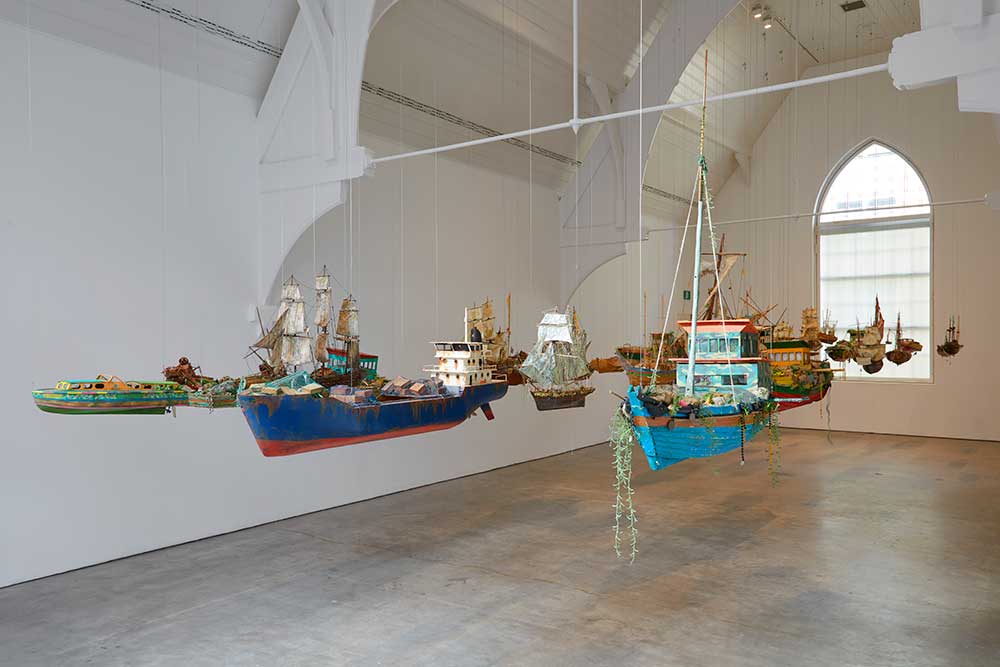
Hew Locke, Armada, 2017-19. Installation view, Here’s the Thing exhibition, Ikon Gallery, Birmingham, 2019. Courtesy the artist and Ikon Gallery. Photo: Stuart Whipps.
Royal Academy of Arts, London
3 February – 28 April 2024
by CHRISTIANA SPENS
Johann Zoffany was known for his group portraits, which were called “conversation pieces”. In The Family of Sir William Young (1767-69), the painter shows the family of Young, a British colonial governor and sugar plantation owner, at leisure, attended to by a young Black man. At the time of its production, this scene reaffirmed notions of British civility, constructing a conceptual distance between Britain and its sources of new wealth, which were premised on the stolen labour and skills of enslaved people. Sir William Young ran plantations in St Vincent, Tobago and Antigua, though, of course, these are out of the picture.
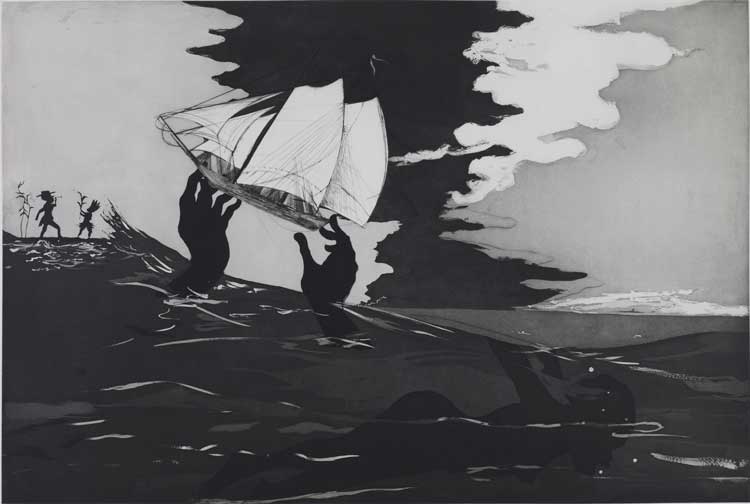
Kara Walker, no world, from An Unpeopled Land in Uncharted Waters, 2010. Etching with aquatint, sugar-lift, spit-bite and drypoint on paper, 68.6 x 99.1 cm. British Museum, London. © Kara Walker, courtesy of Sikkema Jenkins & Co. and Sprüth Magers.
As I looked at this painting, with its luxurious dresses and blooming tree, its vast landscape, I was reminded of scenes in Jonathan Glazer’s film Zone of Interest, in which Rudolf Höss and his family relax and play in their flowering garden in the height of summer, having planted trees to partially conceal the barbed wire lining the top of the fence that separates them from Auschwitz. In the film, Hedwig, the wife of the commander, takes the belongings of Jews who have been sent into the camp – a fur coat, even a lipstick – and warns their new maid, a local Jewish girl, that her husband could turn her to ashes should she demand it. At night, the skies turn red from the fire of the incinerators, and there are screams and shots, but the family remain in a pretence of ignorance of what is happening yards away from them – the murder of a million people, at the father’s command. In the garden scenes, the Höss family and their friends relax and laugh as this goes on, the girls wearing white dresses and bows in their hair and the boys in lederhosen, sometimes playing in a little pool. They even swim in the river, until Rudolf finds a human jawbone, and quickly hurries the children home so that they can be cleaned thoroughly after this accidental contamination. Another time, Hedwig talks of their dream to farm the land when the war is over; a gardener ploughs human ashes into the soil.
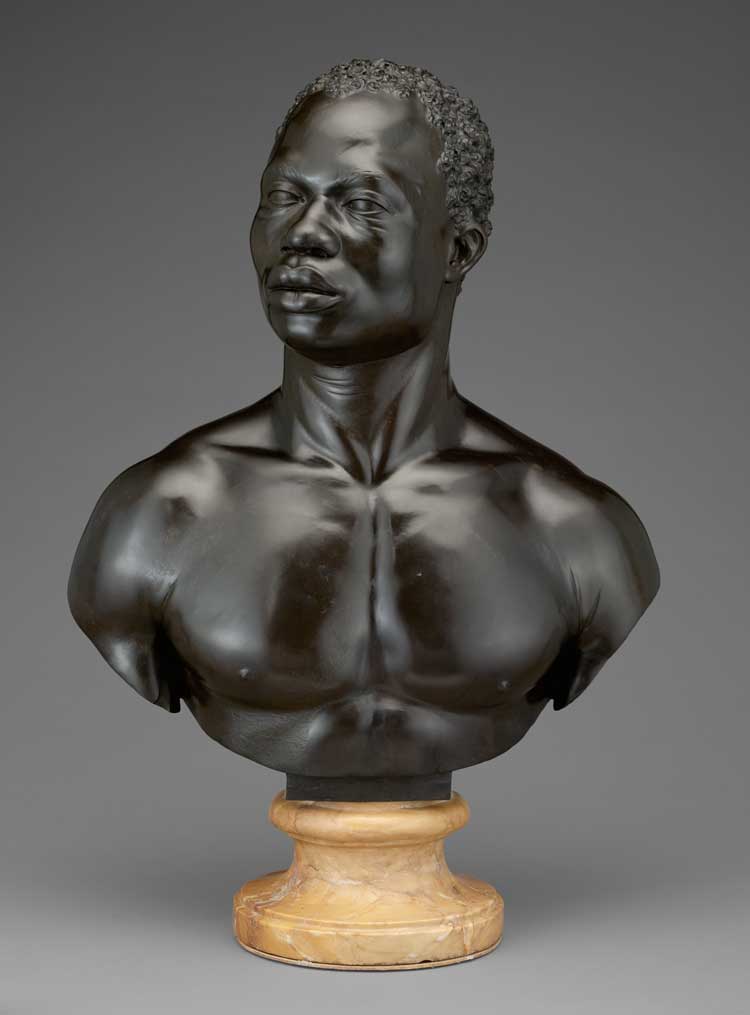
Francis Harwood, Bust of a Man, 1758. Black stone (pietra di paragone) on a yellow Siena marble socle, 69.9 x 50.2 x 26.7 cm. The J. Paul Getty Museum, Los Angeles. Digital image courtesy of Getty’s Open Content Program.
The colonialists’ new lives were similarly built on the death and theft of enslaved populations. While the Germans were relatively efficient at facing their collective guilt after the Holocaust, the British have taken their time. The Royal Academy was founded at the height of the empire and its transatlantic slave trade, and now it interrogates that past. Colonialist landscapes are juxtaposed with contemporary works that challenge those idealised scenes and help to elevate non-western perspectives. Zoffany shows wealthy white colonial families such as that of East India Company officer Colonel Blair, while in Imaginary Edens/Photos of My Father (2005-15), Mohini Chandra uses photocollage to explore her own family’s “diasporic experience of in-between-ness”. These clashing ideas of utopia are fascinating, laying claim not simply to place but also the freedom to envision togetherness and peace.
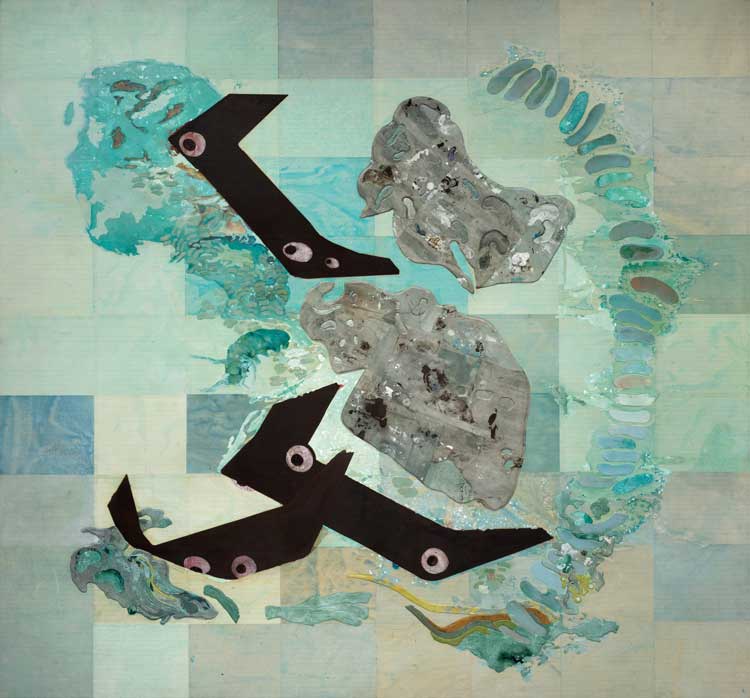
Ellen Gallagher, Whale Falls, 2017. Oil, acrylic, ink and paper on canvas, 188 x 202 cm. The Ekard Collection. © Ellen Gallagher. Courtesy the artist and Hauser & Wirth. Photo: Ernst Moritz.
In Zone of Interest, there is a scene towards the end where we see the modern-day Auschwitz, with piles of shoes and suitcases displayed behind glass, and the uniforms worn by Jewish prisoners. We don’t see any atrocities in the film, but this evidence of all the lives lost is profoundly haunting. Similarly eerie and melancholic is Karen McClean’s Primitive Matters: Huts (2010), an installation of wooden huts against projections of grand houses in Port of Spain, Trinidad), reminding us of who lived, out of sight, now gone. In another room, models of ships are suspended from the ceiling in an installation by Hew Locke, representing a fleet of slave ships, and the transportations of enslaved people over the Atlantic, where they either died or faced perpetual slavery in America. The rooms feel haunted, as they should; the pain and guilt are palpable. There are expansive paintings by Ellen Gallagher and Frank Bowling, whose works express trauma and loss, drawing from the work of JMW Turner, whose 1840s paintings show Britain’s role in the slave trade as well as whaling, creating an atmosphere of peril and eeriness.
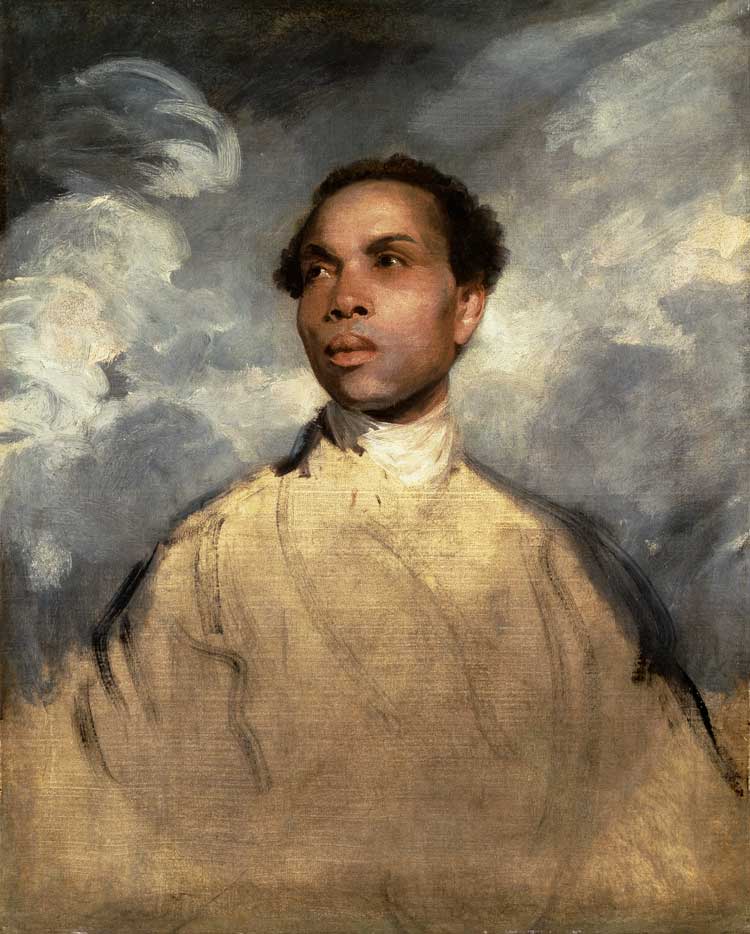
Sir Joshua Reynolds PRA, Portrait of a Man, probably Francis Barber, c1770. Oil on canvas, 78.7 x 63.8 cm. The Menil Collection, Houston. Photo © Hickey-Robertson, Houston.
Towards the end of the exhibition is Frederick William Elwell’s The Royal Academy Selection and Hanging Committee, 1938, featuring 14 white men at lunch in a grand room. These are the gatekeepers themselves, or some of them. Nearby is a sculpture by Yinka Shonibare, Justice for All (2019), a female figure with a globe as her head, wearing a pink floral dress and holding a sword and set of scales. Her shadows jut out on the grey walls behind, so that there are three figures altogether, arms outstretched, fighting for justice. The weight of the past, so entangled and painful, and the specific injustices that were the result of individual actions, were enabled by complicit communities and a global system of exploitation; justice for all must be a group effort.
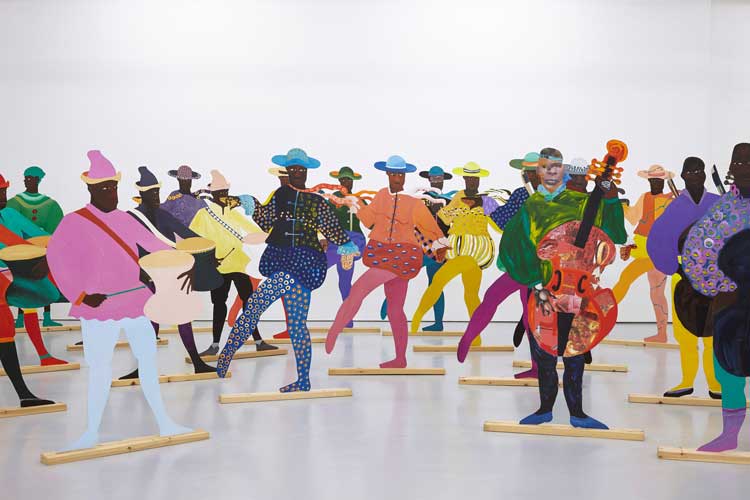
Lubaina Himid, Naming the Money, 2004. Installation view of Navigation Charts exhibition, Spike Island, Bristol, 2017. © Lubaina Himid. Image courtesy the artist, Hollybush Gardens, London and National Museums, Liverpool. © Spike Island, Bristol. Photo: Stuart Whipps.
Outside in the courtyard there is a new gathering, in the form of Tavares Strachan’s major sculpture, The First Supper (2021-23), in which larger than life figures, in gold and black, are seated around a table. It is majestic, a utopian gathering of historically significant figures from the continent of Africa and its diasporas – including fighter Zumbi Dos Palmares, nurse Mary Seacole, activists Harriet Tubman, Marcus Garvey and Marsha P Johnson, and other figures both well-known and forgotten. This is in welcome contrast to the previous painting of Royal Academy gatekeepers, and symbolic of this exhibition’s fresh retort to previously closed discussions. Here are new seats at the table, a new table, in fact. In contrast to Zoffany’s “conversation pieces” at the beginning of the show, in which the only black person was an attendant and where atrocities were kept from view, this is a galvanising vision for the future – new conversations that are not closed but open, not exploitative but freeing. At least, we can hope so.
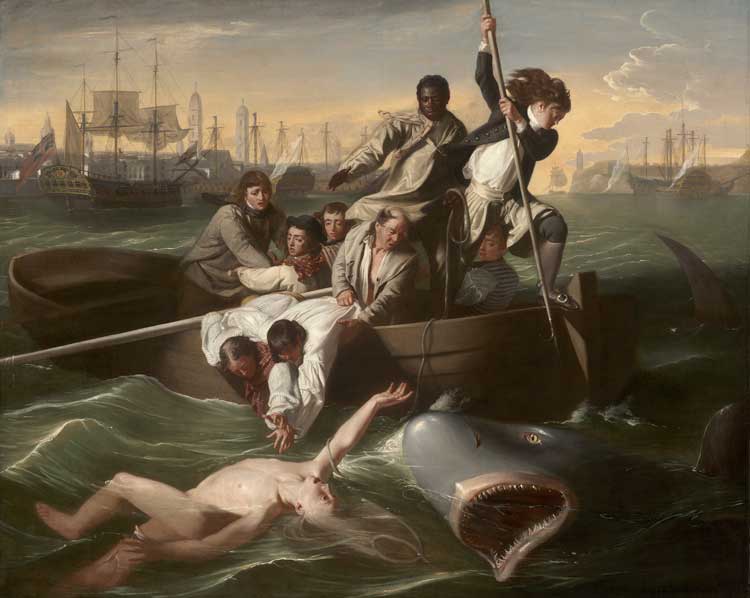
John Singleton Copley, Watson and the Shark, 1778. Oil on canvas, 183.5 x 229.6 cm. Museum of Fine Arts (MFA), Boston. Photograph © 2023 Museum of Fine Arts, Boston.